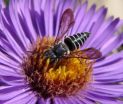(Press-News.org) The brain adds new cells during puberty to help navigate the complex social world of adulthood, two Michigan State University neuroscientists report in the current issue of the Proceedings of the National Academy of Sciences.
Scientists used to think the brain cells you're born with are all you get. After studies revealed the birth of new brain cells in adults, conventional wisdom held that such growth was limited to two brain regions associated with memory and smell.
But in the past few years, researchers in MSU's neuroscience program have shown that mammalian brains also add cells during puberty in the amygdala and interconnected regions where it was thought no new growth occurred. The amygdala plays an important role in helping the brain make sense of social cues. For hamsters, it picks up signals transmitted by smell through pheromones; in humans, the amygdala evaluates facial expressions and body language.
"These regions are important for social behaviors, particularly mating behavior," said lead author Maggie Mohr, a doctoral student in neuroscience. "So, we thought maybe cells that are added to those parts of the brain during puberty could be important for adult reproductive function."
To test that idea, Mohr and Cheryl Sisk, MSU professor of psychology, injected male hamsters with a chemical marker to show cell birth during puberty. When the hamsters matured into adults, the researchers allowed them to interact and mate with females.
Examining the brains immediately after that rendezvous, the researchers found new cells born during puberty had been added to the amygdala and associated regions. Some of the new cells contained a protein that indicates cell activation, which told Mohr and Sisk those cells had become part of the neural networks involved in social and sexual behavior.
"Before this study it was unclear if cells born during puberty even survived into adulthood," Mohr said. "We've shown that they can mature to become part of the brain circuitry that underlies adult behavior."
Their results also showed that more of the new brain cells survived and became functional in males raised in an enriched environment – a larger cage with a running wheel, nesting materials and other features – than in those with a plain cage.
While people act in more complicated ways than rodents, the researchers said they hope their work ultimately sheds light on human behavior.
"We don't know if cells are added to the human amygdala during puberty," Sisk said, "but we know the amygdala plays a similar role in people as in hamsters. We hope to learn whether similar mechanisms are at play as people's brains undergo the metamorphosis that occurs during puberty."
###
The National Institutes of Health funded the research.
Michigan State University has been working to advance the common good in uncommon ways for more than 150 years. One of the top research universities in the world, MSU focuses its vast resources on creating solutions to some of the world's most pressing challenges, while providing life-changing opportunities to a diverse and inclusive academic community through more than 200 programs of study in 17 degree-granting colleges.
Brain adds cells in puberty to navigate adult world
2013-03-05
ELSE PRESS RELEASES FROM THIS DATE:
Early antiretroviral treatment reduces viral reservoirs in HIV-infected teens
2013-03-05
A study led by University of Massachusetts Medical School professor and immunologist Katherine Luzuriaga, MD, and Johns Hopkins Children's Center virologist Deborah Persaud, MD, highlights the long-term benefits of early antiretroviral therapy (ART) initiated in infants.
The study, presented on March 4 at the 20th annual Conference on Retroviruses and Opportunistic Infections (CROI) in Atlanta, shows that ART administered in early infancy can help curtail the formation of hard-to-treat viral sanctuaries — reservoirs of "sleeper" cells responsible for reigniting infection ...
Discovery of 'executioner' protein opens door to new options for stroke ALS, spinal cord injury
2013-03-05
Oxidative stress turns a protein that normally protects healthy cells into their executioner, according to a study released today in the Proceedings of the National Academy of Sciences journal.
Alvaro Estevez, an associate professor at the University of Central Florida's College of Medicine, led the multi-university team that made the discovery, which could eventually help scientists develop new therapies to combat a host of conditions from stroke to Lou Gehrig's disease
Researchers have long known that oxidative stress damages cells and results in neurodegeneration, ...
'OK' contact lenses work by flattening front of cornea, not the entire cornea...
2013-03-05
Philadelphia, Pa. (March 04, 2013) - A contact lens technique called overnight orthokeratology (OK) brings rapid improvement in vision for nearsighted patients. Now a new study shows that OK treatment works mainly by flattening the front of the cornea, reports a recent study, "Posterior Corneal Shape Changes in Myopic Overnight Orthokeratology", appearing in the March issue of Optometry and Vision Science, official journal of the American Academy of Optometry. The journal is published by Lippincott Williams & Wilkins, a part of Wolters Kluwer Health.
"This study appears ...
UCSB physicists make discovery in the quantum realm
2013-03-05
(Santa Barbara, Calif.) –– Physicists at UC Santa Barbara are manipulating light on superconducting chips, and forging new pathways to building the quantum devices of the future –– including super-fast and powerful quantum computers.
The science behind tomorrow's quantum computing and communications devices is being conducted today at UCSB in what some physicists consider to be one of the world's top laboratories in the study of quantum physics. A team in the lab of John Martinis, UCSB professor of physics, has made a discovery that provides new understanding in the quantum ...
60 percent loss of forest elephants in Africa confirmed
2013-03-05
NEW YORK (EMBARGOED UNTIL March 4, 2013, 5 PM U.S. Eastern Time) — African forest elephants are being poached out of existence. A study just published in the online journal PLOS ONE shows that across their range in central Africa, a staggering 62 percent of all forest elephants have been killed for their ivory over the past decade.
"The analysis confirms what conservationists have feared: the rapid trend towards extinction – potentially within the next decade – of the forest elephant," says Dr. Samantha Strindberg of the Wildlife Conservation Society (WCS), one of the ...
Functional electrical stimulation cycling promotes recovery in chronic spinal cord injury
2013-03-05
VIDEO:
In FES cycling, small electrical pulses are applied to the paralyzed muscles of an individual, stimulating the muscles to cycle on a stationary recumbent bicycle. The repetitive activity simulates movement...
Click here for more information.
(Baltimore, MD) – A new study by Kennedy Krieger Institute's International Center for Spinal Cord Injury (Epub ahead of print) finds that long-term lower extremity functional electrical stimulation (FES) cycling, as part of a rehabilitation ...
Daily-use HIV prevention approaches prove ineffective among women in NIH study
2013-03-05
Three antiretroviral-based strategies intended to prevent HIV infection among women did not prove effective in a major clinical trial in Africa. For reasons that are unclear, a majority of study participants—particularly young, single women—were unable to use their assigned approaches daily as directed, according to findings presented today by one of the study's co-leaders at the Conference on Retroviruses and Opportunistic Infections (CROI) in Atlanta.
The Vaginal and Oral Interventions to Control the Epidemic (VOICE) study, or MTN 003, was designed to evaluate the ...
Study shows mirabegron effective and well tolerated for overactive bladder
2013-03-05
New York, NY, March 4, 2013 – In a new phase III trial mirabegron, a β3-adrenoceptor agonist, given once daily for 12 weeks, reduced the frequency of incontinence episodes and number of daily urinations, and improved urgency and nocturia in adults with overactive bladder (OAB) compared to those in a placebo group. The incidence of common adverse events (hypertension, urinary tract infection, headache, nasopharyngitis) was similar in the mirabegron and placebo groups in this study. Rates of dry mouth and constipation were similar in the drug and placebo groups. The ...
New research confirms plight of bumble bees, persistence of other bees in Northeast
2013-03-05
A new study shows that although certain bumble bees are at risk, other bee species in the northeastern United States persisted across a 140-year period despite expanding human populations and changing land use. Led by Rutgers University and based extensively on historical specimens from the American Museum of Natural History and nine other bee collections, the study informs conservation efforts aimed at protecting native bee species and the important pollinator services they provide. The results are published today in Proceedings of the National Academy of Sciences.
Eighty-seven ...
Protein synthesis blocker may hold key to reducing effects of traumatic events
2013-03-05
Reducing fear and stress following a traumatic event could be as simple as providing a protein synthesis blocker to the brain, report a team of researchers from McLean Hospital, Harvard Medical School, McGill University, and Massachusetts General Hospital in a paper published in the March 4 issue of Proceedings of the National Academy of Sciences.
"This is an important basic neuroscience finding that has the potential to have clinical implications for the way individuals with posttraumatic stress disorder are treated," said Vadim Bolshakov, PhD, director of the Cellular ...


